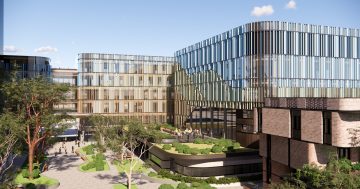
Fiona Carrick, Woden Valley Community Council president, in front of the towers where the basketball stadium once stood. Photo: Fiona Carrick.
The waiting list of people wanting to play community basketball in Canberra currently stands at over 100. But there are even more people who have shown an interest in playing.
According to Basketball ACT CEO David Simpson, beyond the waiting 100, plenty more chose not to go on a waiting list.
“We are also aware of potential players, both seniors and juniors, that have been turned away by our member clubs. Unfortunately, we don’t have any firm figures on the numbers that clubs have turned away, so it’s all anecdotal. We also don’t know how many then bounced across to another club,” Mr Simpson says.
The reason there are waiting lists and disappointed players cooling their heals at home instead of being on a court is clear: there are simply not enough indoor facilities in the ACT to cater for the participants. And the demand is only set to increase. There’s already been a 40 per cent increase in sport participation since 2020.
Facilities are being stretched to the absurd in the ACT, with competitions running until 11 o’clock at night.
The ACT Government has encouraged indoor sports to utilise school facilities but there are inherent issues in this approach.
In the Woden area, which is reflective of most of the other town centres in the ACT, one club uses seven different school facilities. This doesn’t support social cohesion through sport, and it must be an administrative nightmare for the clubs.
The Woden precinct provides an ideal snapshot of the squeeze sports clubs face in finding adequate facilities as the population explodes due to high-rise development. The Woden Valley Community Council estimates that there are 30 towers over nine storeys in the Woden precinct, which are either already built or proposed.
“We are losing our sporting facilities to apartment towers so we need to plan for new facilities to service the growing population across the region,” Woden Community Council president Fiona Carrick says.
“In 2015 we lost our basketball stadium, we lost the pitch and putt course, the bowling greens and tennis courts. The swimming pool remains closed and improvements are unlikely to be made to the ice rink while the government promotes the building of a new facility at Tuggeranong.”
As well as the ice rink, Woden does have a gated cricket and AFL ground. This is a ground used by league and union. There are also squash courts, a track and field facility and a skate park.

Land next door to the Belconnen Basketball Stadium has been found suitable for more courts. Photo: Jennifer Andrew.
Indoor sports such as basketball and futsal appear to be left to their own devices, and this includes utilising school facilities.
David Simpson says the facility shortage in the Woden area has become critical.
“Woden is an area in desperate need of indoor basketball facilities,” he says.
Mr Simpson also has his hands full catering to the growing numbers wanting to play the sport across the ACT.

Belconnen Basketball Stadium. Photo: Jennifer Andrew.
He says the land next to the Belconnen Stadium is available to build more courts.
“We’ve got land next to the stadium. We have done feasibility studies which support the concept, but we need government support. To give you an example of the pressure on facilities across Canberra, we have Gungahlin teams playing each other in Tuggeranong.”
Basketball ACT is also looking at the possibility of turning outdoor courts adjacent to the Belconnen Stadium into an indoor facility.
In many ways, it is being left to the sports organisations to resolve the facilities shortfall.
David Simpson says the need for a transparent facilities strategy for Canberra has never been more urgent, while Fiona Carrick is adamant that the provision of community facilities should not be left to the peak sporting bodies or developers who have their own agendas. There is a need for government intervention to ensure an equitable distribution of facilities across Canberra.
“Each town centre should have a major multipurpose indoor facility,” Ms Carrick says.
Woden, it would appear, is in most urgent need at the moment given the rapid pace of development, with basketball at the forefront of that shortfall in indoor facilities at Woden.





















